Recently I was fortunate enough to attend a National Wood Flooring Association seminar entitled “Understanding Relative Humidity in Your Home”. The seminar was very informative and I will share the information with you.
Being in the Northeast Region, we are exposed to extremely cold dry winters and very humid summers. Without any humidity control, the same house with extreme spaces between the boards in the heating season, could become cupped in the high humidity of the summer.
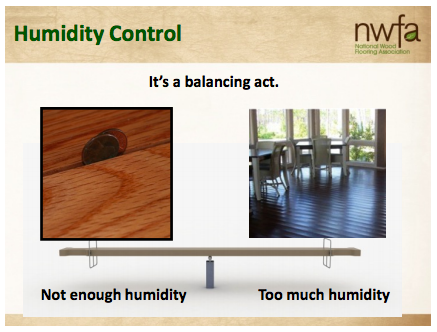
Water vapor is a gas, it will fill any space; however, other forces such as air movement, due to temperature stratification, have a strong effect on the dispersion of humidity. Normal living conditions are considered 65-75 degrees Fahrenheit (18-24 C) with a relative humidity between 30-50%. This is the range that is best for your health which is also best for your wood flooring.
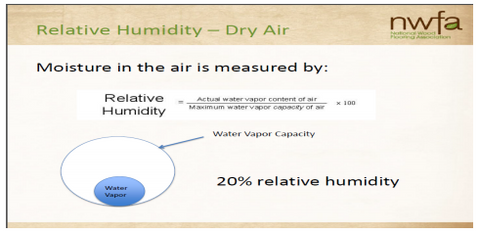
The Human Health chart, pictured below, clearly shows the effects of below 30% and above 50% Relative Humidity for bacteria, viruses, respiratory infections, allergic rhinitis and asthma problems. If you have pets, and let your RH get above 50%, it is almost certain that you will have dust mites. Although not visible they are there feeding daily on flakes of skin from humans and pets.
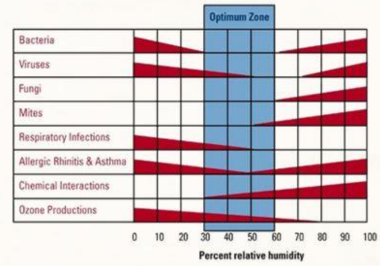
Signs of dust mites include sneezing, runny nose, and signs of asthma such as wheezing and difficulty breathing. They cannot exist in humidity levels below 50%. A study in 2000 found that more than 45% of American homes had detectable dust mite levels associated with the development of allergies, and 23% had bedding with concentrations of allergens high enough to trigger asthma attacks. I am getting itchy just thinking about these creatures.
In the past, I was only concerned with the humidity levels inside the home because that is where our product would be, I just assumed the outside air came inside and became inside air. What I did not realize was the amazing effect temperature has on humidity and as a result, hardwood flooring. The upcoming illustrations will make this much easier to understand.
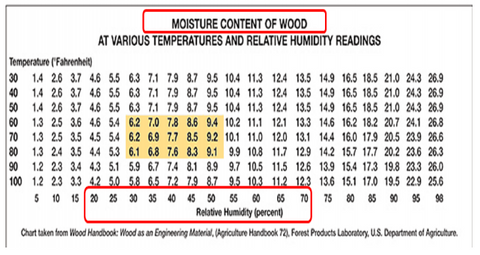
The below slide is a typical winter day with an outside temperature of 10 F (-12 C) and RH of 70%. When this air enters the house and is heated to 70 F (21 C) the RH drops to a shocking 6%. As I am writing this article I see the outside temperature is -11 F (-24 C) which would make the RH of the reheated air almost nothing. As the temperature drops your heating system is running more frequently which makes it impossible to keep your humidity between our 30-50% without adding moisture to the environment.
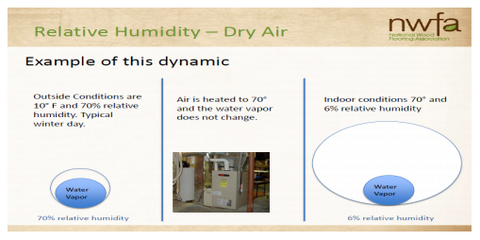
Long stretches of cold weather and not adding moisture back into the house is not only damaging to your solid or engineered hardwood flooring but it effects all wood products and any wood products attached to them such as crown moulding, baseboard, countertops, cabinet doors, etc.
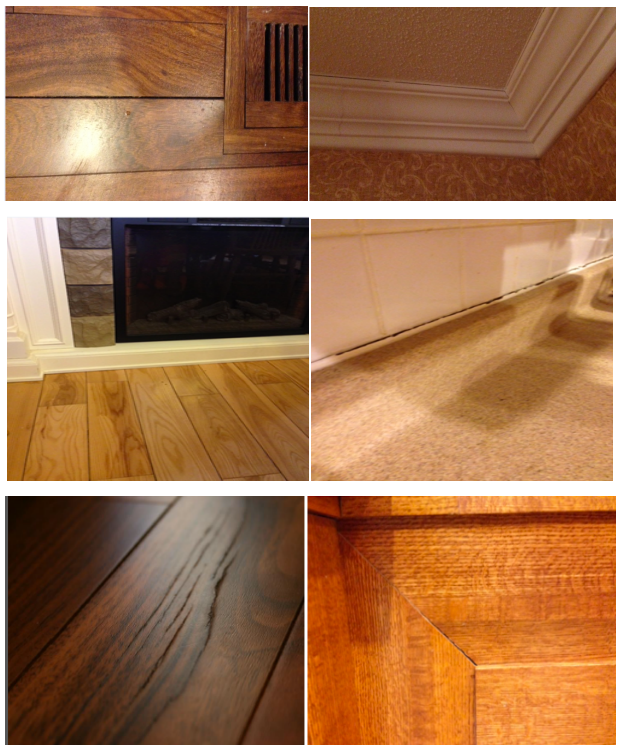
Removing nearly all the moisture from the wood can stress the wood beyond its limitations especially the poor quality engineered wood manufactured offshore. Some situations where boards have shrunk and developed spaces will correct themselves when moisture is added back into the home.

Other issues such as cracks in the boards or caulking that has separated will not usually correct themselves. When manufacturing our products, we must consider the movement of the wood as well as the movement of the finish. With our engineered flooring we must consider three products that must move together, the plywood, the wood and the finish. Inside the 30-50% RH normal minor issues may occur, but the further outside of the preferred RH range the more problems are almost certain to occur. Wood will behave like wood.
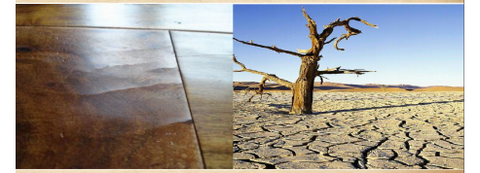
We have spent most of our time talking about cold air being heated and RH dropping. When warm humid air is cooled the RH rises 2.2% for each 1 degree Fahrenheit. In a crawl space, the moisture comes from two sources; the ground and the outside air. The soil will wick moisture, through capillary action, from moist to dry areas. Water does very little to ruin a home with a dirt crawl space as it seldom touches any of the joists, sill plates, girders or insulation. It is the water vapor that causes the wood to mold and rot. Condensation makes everything wet which will stimulate mold to grow and wood to rot.

Crawl spaces are typically dark, damp and cool. We will look at an example of a typical summer day in the Northeastern region. Outside air at 80F degrees with a RH of 70% enters into a 64F crawl space. Let’s look at the numbers. 80F- 64F=16 x 2.2=35.2% rise in humidity; 70% plus 35.3%= 105.3% RH. We can’t have over 100% humidity because the air can’t hold more than 100% as it has reached its capacity. This air will then condense on the cold surfaces causing the air to give up its moisture as the relative humidity has reached its capacity to hold moisture. Condensation will form on the heating/cooling ducts, the water pipes, the block walls, the joists and the bottom of subfloor. The moisture in the subfloor will migrate up into the hardwood flooring causing it to cup, crack and sometimes buckle.
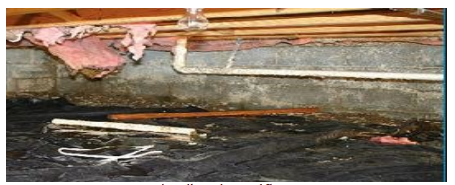
I have used a crawl space as the example but it is similar in basements if the conditions are created. Quite often people open basement windows to get rid of the stale air. With the same outside conditions as the above example (80 degrees F and 70% RH) with a basement temperature of 70F and RH of 40% here is what happens when not factoring in the higher outside humidity coming in: 80F-70F=10 x 2.2=22.2% rise in RH which will bring the new RH to 62% which is out of our recommended range. If you notice a smell in your basement or on things stored in your basement you most likely have a moisture problem. I suggest getting it under control by closing your basement windows and operating an appropriate size dehumidifier to remove this moisture; also there is a Humidex system that I am researching that seems quite simple and the company claims it will do a better job than a dehumidifier and would be less expensive to operate. Getting the humidity under control will lessen the odours.
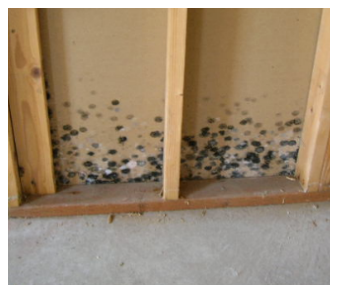
In the above picture the mold was not visible until the drywall was removed from the wall. In a new home the concrete will release moisture for 1.5 to 2 years. This picture illustrates how the wood has absorbed the moisture from the concrete and drawn it up into the space. With this additional moisture and no air movement, the mold thrives.
The below chart shows how many gallows of water are needed to be added to a home in order to maintain the minimum 30% relative humidity at 75o F (24o C). Tight homes are new homes that are built with today’s standards.
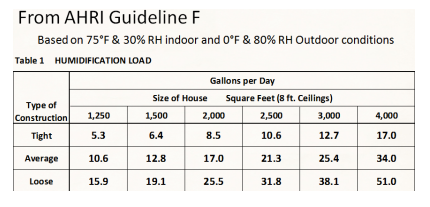
You likely don’t go down into your crawlspace unless you absolutely have to because of the damp musty smell. If you think that by shutting the door you have left that environment behind you are terribly wrong; due to the “Stack Effect” up to 50% of the air you breathe in your home comes from the crawl space.

The circulation in your home allows for up to 70% of the air you breathe to come from the basement. If your basement has a musty smell, this is not healthy to breathe as the health chart (discussed earlier) indicates. The musty smell is the result of the off gassing of the developing mold.

As the above chart indicates, the higher the quality of your windows, the less heat loss and condensation you will have.